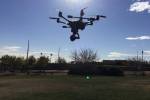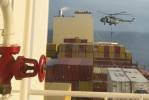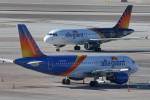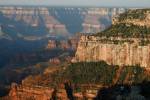FAA probes Mount Charleston copter crash
The pilot of a helicopter that crashed Sunday on Mount Charleston has high ratings with the Federal Aviation Administration but had been involved in a crash landing of a helicopter in February on a Southern California beach.
While FAA policy precludes identifying the pilot, an official with knowledge of the incident confirmed that Olivier Monseu, of Carlsbad, Calif., was at the controls of the Robinson R-44 II helicopter before it crash-landed and caught fire 6:30 p.m. Sunday on rocky terrain near the mountain’s 11,916-foot peak after departing from North Las Vegas Airport.
Monseu and two passengers were transported one at a time to a lower elevation near Kyle Canyon by a Metropolitan Police Department search-and-rescue helicopter.
A male passenger was then taken by another helicopter to University Medical Center with second-degree burns on his chest and face. A female passenger suffered a head injury and was taken to the hospital by ambulance. Their names weren’t available today.
Monseu refused medical treatment, according to a witness at the transfer location.
FAA spokesman Ian Gregor said investigators from his agency and the National Transportation Safety Board spoke to the pilot by phone this afternoon.
“We’ll get to the bottom of this and find out exactly what happened,” Gregor said.
FAA records show Monseu is rated as an airline transport pilot and holds commercial privileges for single-engine planes and helicopters.
As the operator of a flight school, he was on board a Robinson R-22 helicopter on Feb. 18, giving a prospective flight instructor a pre-employment check ride when it made an emergency landing south of Swami’s Beach in Encinitas, Calif. As part of a practice maneuver, the prospective flight instructor was trying to land the aircraft without power, according to a story in a San Diego area newspaper, the North County Times.
A lifeguard at the scene described Monseu as the passenger who told him he owned the aircraft and heads a flight instruction company.
The National Transportation Safety Board’s brief of that accident doesn’t name Monseu but said the 39-year-old pilot in command “also operated the flight school that owned the helicopter.”
No one was hurt in that incident in which the helicopter impacted wet sand, causing it to flex with its rotor blades striking its tail.
Attempts to reach Monseu in Carlsbad were unsuccessful today. And, there was no telephone number listed for the corporation, Olisofi LLC, that, according to the Airport-Data.com Web site, once owned the Robinson R-44 II helicopter that crashed Sunday.
FAA records show the current registered owner of the helicopter is the Bank of Utah in Salt Lake City.
Brian Lorenz, helicopter expert for 702 Helicopters, said the helicopter could have been flying too close to its brand’s capacity, which could have contributed to the crash.
He said the 2004 Robinson R-44 II helicopter is rated for flight up to 14,000 feet above sea level and, although the crash occurred at about 11,500 feet, warm temperatures in surrounding areas make the aircraft perform differently.
Due to higher density altitude, the helicopter “thinks” it’s higher than it really is, Lorenz said.
“In layman’s terms, if you’re outside and cutting the grass on a normal day you’re going to be fine, but if you’re outside cutting the grass in 110-degree temperatures, you’re not going to perform at your best,” Lorenz said.
He added that with fuel and three people on board, the helicopter could have been close to maximum gross weight.
Mount Charleston has historically been a treacherous place to fly aircraft.
Last year, two couples from Contra Costa County, Calif., were killed when their Piper Cherokee airplane crashed in Kyle Canyon after it swooped to a low altitude and clipped some power lines.
In 1955, a C-54 transport plane shuttling workers to the classified Area 51 airstrip mistakenly flew up Kyle Canyon in poor visibility and struck a snow-covered area near Charleston Peak, killing all 14 on board.
In order to avoid potential wind-direction hazards in Lee Canyon, company officials for Mercy Air decided three years ago to stop making helicopter pickups of injured skiers at the resort. Instead the pickups have been made at a lower elevation transfer point near Kyle Canyon.
“We weren’t comfortable with a single way in and a single way out,” said company spokesman Craig Yale.
Dennis Darling, district fire management officer for the U.S. Forest Service, said there are no restrictions for helicopters flying over Mount Charleston Wilderness as long as they maintain an altitude that’s at least 500 feet above ground level. Landing in the wilderness area is prohibited. “People don’t realize the winds up there,” Darling said.
He said the pilot in Sunday’s crash refused to be transported to a hospital.
“He should be given some kudos for getting that thing down with minimal injuries. That in itself was a feat,” Darling said.
Contact reporter Keith Rogers at krogers@reviewjournal.com or 702-383-0308.























